30 ways to experiment with acquisition, product, and virality to get more growth

.png)

.png)
Add vinegar to baking soda, and you'll get a volcano. The science is simple: an acid reacts with a base. But the effect is big and gets you an A with your teacher. Growth hacking requires the same experimental mindset. Mix elements together in the right way, and you'll turn them into something bigger. Although the internet's filled with advice for how to hack growth, finding the right mix of elements is tricky. “What happens when you change the color of your CTA from red to green? Will you get a lot more sign-ups with a 'Sign-up With Google' button?”Maybe. The only way you can find out is by testing. Experiment with a technique, learn from the results, and iterate. Growth means different things during different points of the user journey, so it's important to recognize the goals of experimenting at each stage (click to jump ahead):
Get back in touch with your science-fair days, and start conducting experiments that will cause reactions in your product. Here are thirty techniques you can plot into your users' lifecycle to scale their initial interest, their engagement, and their loyalty.
The more people see you, the more chances you have of finding the right audience. Use these growth hacking techniques to grow your email list, pull in potential users with great content, and shape your SEO strategy to boost your authority.
Personalized emails improve click-through rates by 14%.Don't reserve segmentation for the later stages of the funnel. Use it at the gateway to your product to make a personal welcome to a potential user. Clearbit, the lead enrichment company, segmented its email list based on customer persona. By using data from their own product, they segmented everyone who signed up for their free trial, from developers to marketers to sales. That way, they could send each persona a highly-targeted welcome email, according to what they would actually use Clearbit for.Take a look at Clearbit's welcome email to developers. It's focused around helping a developer get up and running with their first API call to Clearbit.

At the acquisition stage, you're jumpstarting your growth from scratch. Publishing a guest post gives you a mouthpiece to talk directly to established audiences, who will listen because you're connected to a platform they already trust.Groove has reached over a million new people through guest blogging, but they built this strategy out from a single post on Buffer. By researching what kind of posts do well at Buffer and catering to its audience of social media marketers, Groove's first guest post drew in 1000 new visitors after just an hour, and an increase in trial sign-ups followed. After the success of this first post, Groove doubled down on the strategy and built out a long list of influencers, reaching out to them via email.
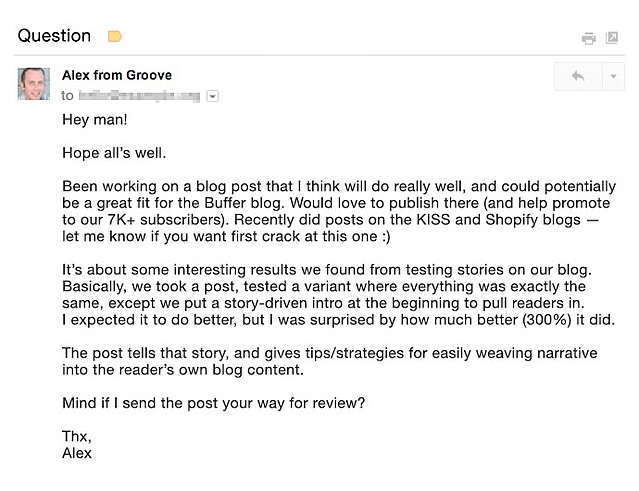
Just because you don't have users yet, it doesn't mean you can't prove your product and start giving value. Building a free tool, like an API, a web analyzer, or a calculator, allows you to deliver value proactively to potential customers, giving them a reason to sign up for your paid product. Clearbit's core product is a data enrichment API. The problem is that marketers and salespeople—the people who would get the most value from Clearbit—don't always know how to use APIs. So Clearbit built a free tool instead, as a standalone product called Connect. Connect is a Chrome extension that enriches leads right in your Gmail inbox, 100% for free, and it's easy for someone with no technical background to use. The tool was so successful that, within the first few months of launch, it drove 100k qualified leads.
Check out the Free Growth Calculator we built at Appcues.
Knowing that other companies you admire or competitors in your industry use a particular tool will make you look at that tool twice. Put testimonials in context by attaching them to your blog. Plant a testimonial CTA right where readers are lapping up insights on your blog.As the reader progresses through the Zapier blog, a little pop-up appears in the corner, with a clear CTA “Try Zapier Today” and a testimonial from a co-founder. Users are used to seeing reviews and testimonials, but this one is a surprise. It builds on this rich piece of content and it's trustworthy, because it offers a specific value proposition from a specific person, not a faceless endorsement.
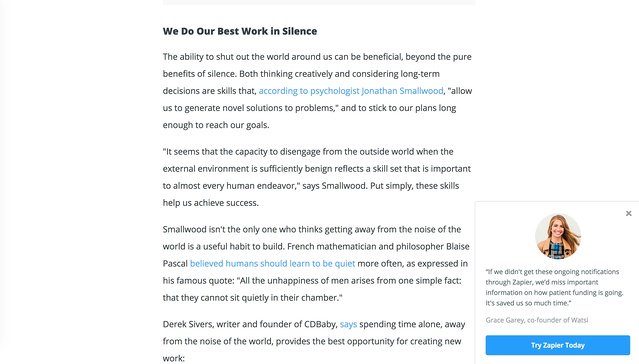
Increase conversions by offering readers a content upgrade like a whitepaper or a template. Make it usable — something readers can take and apply to their business — and they'll be happy to trade you for it by giving you their email address. Brian Dean, of Backlinko, added the upgrade below to an average-performing blog post. Perusing Google's ranking factors was interesting, but what really motivated readers was being able to check their own sites against the most important factors. The upgrade was an interactive document, a checklist readers could take and use right away to improve their own rankings. Because of this, they were willing to give up their email, and Banklinko increased conversions by 785% on that page.
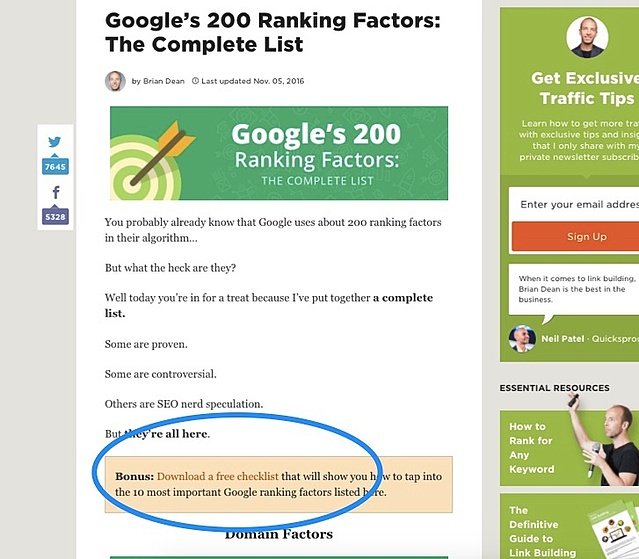
For early-stage startups that don't have the time or marketing resources to manage a blog, building a content academy is a low-effort, high-reward approach to start content marketing. We did this at Appcues with the User Onboarding Academy. It's a single page, with a title, a table of contents, and an evolving library of links and resources, categorized into topics like “Best Practices,” “Examples” and “Aha! Moments.”As our CEO and co-founder Jonathan wrote, the Academy had a few key benefits:
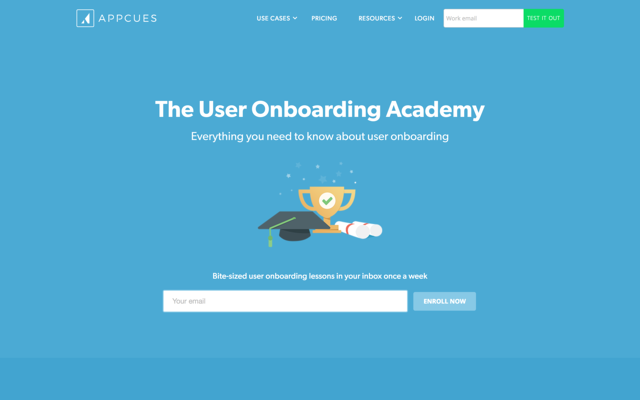
Growing your authority with keywords is like building a gravitational pull on potential customers. As they go about their daily searches, there you are, answering their questions and providing value.Test your keyword strategy with an initial bundle that corners an area of expertise important to your target customers. Create a set of terms, including a short tail and several long tail keywords.
Optimize your posts for these keywords and then track what kind of customers start flocking and where they're coming from. Experiment until you're pulling in your ideal customers.
Add insight to your SEO strategy by checking out how your competitors are ranking. Use competitors' keyword authority to inform your own strategy and track your site in comparison with theirs.
Good content — in the form of in-depth, actionable, and original blog posts — can make you a favorite with Google and give your site the authority it needs to attract new users. When Neil Patel saw that his posts weren't getting read, he investigated. He found that posts over 2000 words were actually more popular, because Google prefers “content-rich sites.” The highest-ranking web page for each keyword has an average of 2,416 words. Spend some quality time enriching your blog posts and watch how your rankings climb and new leads filter in to your site.
Find non-competitive ad opportunities to target users and drive them into specific pages in your app. With super-specific hyperlinks, you can find customers as they search for specific expertise that you own, without having to contend with crowds of competitors for more general search terms. Hotel Tonight, an aggregate app for hotel deals, used this technique to serve customers who were searching specific destinations or times, like “hotel in las vegas tonight" rather than “hotel in las vegas.” Using a tool called Branch, Hotel Tonight installed deep links into its web ads, taking searchers right into the relevant city page. Install to booking conversion rate increased by 18% because customers were actually being guided to Hotel Tonight over other, more established sites.

It's practically impossible to create the most effective ad on the first try—you need to test different variants to target demographics and zero in on the best ads for conversion. By using Facebook Ads alongside a tool like AdEspresso, you can target ads towards segments of users, such as people who have visited your page but didn't convert. Use ads over a limited time frame with the goal of reactivating those users. Narrow in on the right recipe of copy and call to action that convinces most users to go back into your product and give it another go.
A fast website isn't so much a growth hack as it is a not-shrink hack. With every second that your site takes to load, a customer gets closer to abandoning you. In fact, Amazonfound that a page load that's delayed by even a second can cost them $1.6 billion in sales every year. Stop your traffic u-turning by passing your site through a tool like Pingdom. It'll show you the load time of your pages and suggest how you can remove blocks to make your site run faster. Set up a regular schedule of checking load times so that your other growth hacks aren't let down by dips in site speed.
Your product is your lab — test everything to create the stickiest possible version. Explore to find opportunities that prove your product's value so that users come back again and again, building a routine. Try out these techniques to see how you can propel users through onboarding by helping them engage with features and re-engaging them when their attention wanes.
Walkthroughs helps users learn your product by compelling them to take specific, meaningful actions. The best walkthroughs understand what new users want from the product, and deliver that value in an engaging way. Slack uses action-driven tooltips to build onboarding walkthroughs. The result is an interactive user experience that sets the user up for deeper product engagement.

Make your user onboarding experience a damn good time, and users will realize the value your product holds for their lives and be more likely to convert. Games are addictive — they reward you more for playing more. Take a leaf out of Nintendo's book as you plot your onboarding sequence. Rather than posing one tooltip after another, design them as a chain reaction — when users complete one core action of your product, they get to progress to the next level. If you see this driving up onboarding completion, you can raise the stakes by displaying the users' progress and rewarding themfor getting to certain stages with extra value.

Tutorials, customer service check-ins, updates — almost everything that users have to learn about your app can be enhanced by video. Test the impact of a video on conversions by adding a video to your onboarding emails. Dropbox spent $50k on their email explainer video, but it worked — the conversion rate of the email jumped 10%, which for Dropbox meant 5 million new customers. The video wasn't a success because of Dropbox's high budget, but because videos are inherently easier to understand than text. The more words your email has, the lower the response rate you'll get. A video is entirely textless, it jumps out at the recipient like a shiny object in an overly verbose inbox.

Who's the one person that can make your new users look twice at an email? The person who built the product. Get more views and click-throughs with this simple hack that's actually easier than the welcome emails you're currently writing. Have your engineer write a single line and send it out to recently onboarded customers. Wagon, the data analytics tool recently acquired by Box, sends a welcome message straight from their engineer, Andy. It's a tiny message, sent from Andy's personal email, phrased on an equal playing field with the recipient. It implies: “This product is a joint effort, let's make it better together.” And guess what? If users think they own Wagon, they're going to use Wagon.
.jpeg)
In-app messages aren't just for handy hints — they can give your user the ability to log their feedback quickly and easily, right when they're experiencing the product. It's like when the masseuse asks “How does that feel?” It's the most timely feedback you can get.What's one question you could ask your users that will drastically improve or customize their experience? This in-app survey is one of the simplest possible, but it gives you a sense of how satisfied your users are at particular moments in their experience. If a user answers “no,” ask them a simple follow up question: “Why?” Share surveys in-app while it's convenient for users to fill them out. You'll find people are more responsive and the answers more accurate. Use these insights to shape your product/market fit and drive organic growth.

While a generic notification will gain you an average 1.5% open rate, that figure shoots up to 5.9% when the content is personalized. When you employ push notifications with care, buffered by permissions and informed by user data (who they are and what they want to achieve with the product), your pushes can be both helpful and intriguing, providing additional value from your app. Netflix uses push notifications to bring users back to their product by carefully selecting show updates they know specific users will be interested in. By adding a timely quality to their message (“now”), Netflix encourages users to act now rather than later, when they're likely to forget.
.jpeg)
Propel discovery by highlighting the updated sections of your app. After the thrill of your game-like onboarding sequence, new users may experience a lag of interest unless they keep discovering ways to use your product better. As a user navigates their new Canva account, little orange buttons appear on certain screens, beside certain headers. Prompted to share their new design, the user realizes that they can just share a link. Canva expertly puts this alert right in the users' path, making the message highly relevant. Even if users don't click the orange button right away, they know that Canva is constantly building new things, reigniting the excitement of when the app was brand new.

Getting data from all your customers is important, but if you're on a quest for growth, it's week one you need to focus on. Week one is responsible for the lion share of your churn. Use a data analytics platform like Amplitude to find week one's drive-by customers and figure out why they left. To further localize retention issues, focus on a particular engagement metric. Segment, the data analytics hub, knows that the most important action for long-term retention is getting users to send their event data to Segment from Day 1. So Segment sends this email to a behavioral cohort they've created based on that action: event data streaming. By giving the user an easier way to complete this action, Segment bridges that week-one drop off.
.jpeg)
When you're contacting users to engage, or re-engage, with your product, don't ask too much of them. At the same time, don't leave them with a vague notion of what your message is about. Turn information into action by tasking users with one easy-to-complete action at the end of every interaction.Noah Kagan does this with his email list. He asks readers to take one action at the end of the email. It's always simple. Noah knows that if he can help users get one thing done that helps them, that initial conversion hurdle will be crossed, and they'll be much more likely to return.

Once you've created reactions that acquire new users and propel those users through your UX, you can multiply those new friends by growth hacking your shareability. Inspire and reward users when they spread the word about your service.
Share graphic quotes on social media and give followers easily-digestible and sharable nuggets of value. Twitter posts with pull quotes get 19% more retweets, while posts with photos get 35% more. Test how big that growth can get by combining the two techniques in a quote image. This quote image from Headspace works to increase the brand's visibility because it doesn't require anything from the viewer. It's a quick hit of inspiration, non-promotional (preferably) and enhances the message of Headspace's core product, a meditation app.

People pass through social media platforms like Twitter in ever-changing waves. The population you reach with one post is likely to be very different from the population you reach with another. That's why sharing the same post multiple times can increase the post's visibility dramatically. Try sharing every post three times. CoSchedule has made this nifty graphic to show how clicks accumulate with multiple postings. The first post garners the most clicks, but follow-up mentions of the same post the next day and the following week boost clicks by over 125%.
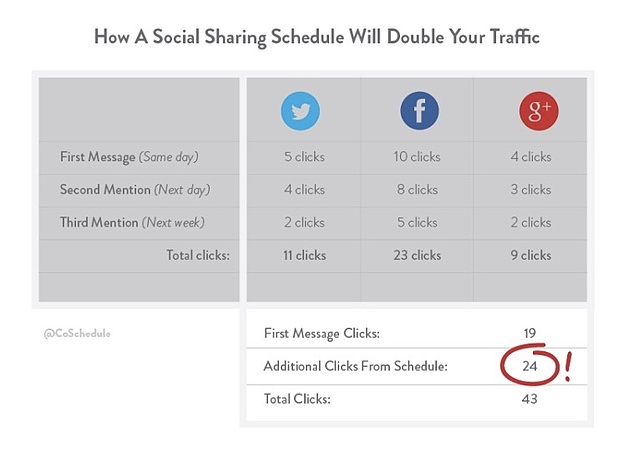
Grow the virality of your product by making social sharing an integral part of how the user gets their value. An API takes your product and makes it flexible by connecting it to other tools where new users can find it. If you're building a product management tool, how do you compete with existing solutions that are in widespread use, like Trello, Asana, or Basecamp? Build an open API and make it really easy for customers to switch over. Airtable is a spreadsheet-like tool that helps you organize your data. It integrates with 600+ apps through its integration with Zapier, and has achieved massive growth with this technique — 682% for the year 2016.By opening up their API to a bunch of different tools, Airtable makes it easier for users to switch from something they were already using, while their simple documentation guides people through building their own integrations.
Qualaroo started out as KISSinsights, a side project of the data analytics platform KISSmetrics. KISSinsights was a simple survey tool that allowed marketers to ask visitors questions on-site.

Because it was a side project, the team didn't have a ton of money to spend on paid acquisition, so they did something else instead. They added a “Powered by” button on the bottom of their survey form. Hiten Shah, one of the co-founders of KISSmetrics, points out that this button was responsible for 100% of their little side-project's growth and got 1,121 websites using their survey tool within months.Free users of KISSinsights would install the survey tool on their site. Their users would click on the “powered by” button, and get taken straight to the KISSmetrics landing page.
Hashtags channel your social media posts, allowing them to be viewed in context by people who are following certain trends or topics, like #GrowthHacking or #NewUsers. Utilize these channels to get your posts in front of new eyes. Research shows that sharing one or two hashtags with a post increases engagement with that post by 21%. Choose your hashtags wisely, and don't overuse them. The engagement level actually starts to drop once you get to three or more hashtags. But experiment with categories to see what gets your product noticed. Find your viral communities.
Don't assume that users won't want to share the news about your service. Provide an easy, frictionless way they can share as soon as they log into your app, and see how this smooth ride boosts your virality. Uber growth hacks its shareability by positioning referrals at the forefront of almost every interaction users have with them. This technique lowers Uber's cost to acquire users and raises its LTV. Referred customers are great customers — they're less likely to churn, they're bigger spenders on average, and, most importantly, they're more likely to make referrals themselves.

How did a company like Dropbox hit crazy viral growth and acquire over 500m million users? There's a one word answer to this question: referral.When Dropbox first launched its product, back in 2009, the company was seeing some traction, but its CPA for traditional paid channels like search and affiliate marketing cost between $233-$388—far too high for a $99 / year product.

So they introduced their referral program. Dropbox provided a dual-sided incentive structure, which simply meant that for every friend you referred, Dropbox gave you and your friend free space on the cloud. It worked big time. Referral helped Dropbox lower it's CAC and increased user signups by 60%, and helped the company sustain 15-20%+ month-over-month growth since launch.
A user's willingness to share can be significantly altered by where and when they're prompted with a referral CTA. Instead of over-prompting by using every kind of nudge in every scrap of spare app space, use testing to find the most effective button.
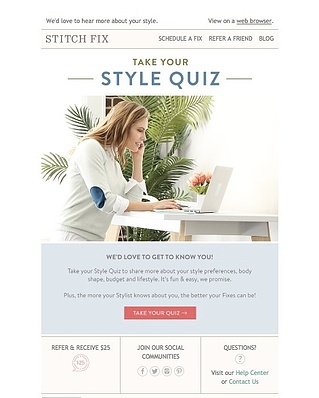
Once you show users that referring pays off, use a follow-up email with a call-to-action to share again. Customers who know how to refer are more likely to refer again. You can nudge customers into the viral loop by making a fuss over them via email whenever they refer.Here's how apparel brand Kule capitalizes on the intent-to-share of its customers. This is a thank you message, but it builds on the referral reward by giving the customer a one-click way to share again.

These 30 techniques are just a tiny sample of the experiments you could try in your business. There's no periodic table for growth hacking. The elements are endless, and you're the pioneer . Every experiment you run will be unique to your business, because it will be fueled by your particular customers and carried by your particular product.Einstein didn't discover the theory of relativity by following established laws. Start with these techniques but then go off on your own. Build a culture of systematic experimentation in your company and you could discover something that no one else has thought of yet.